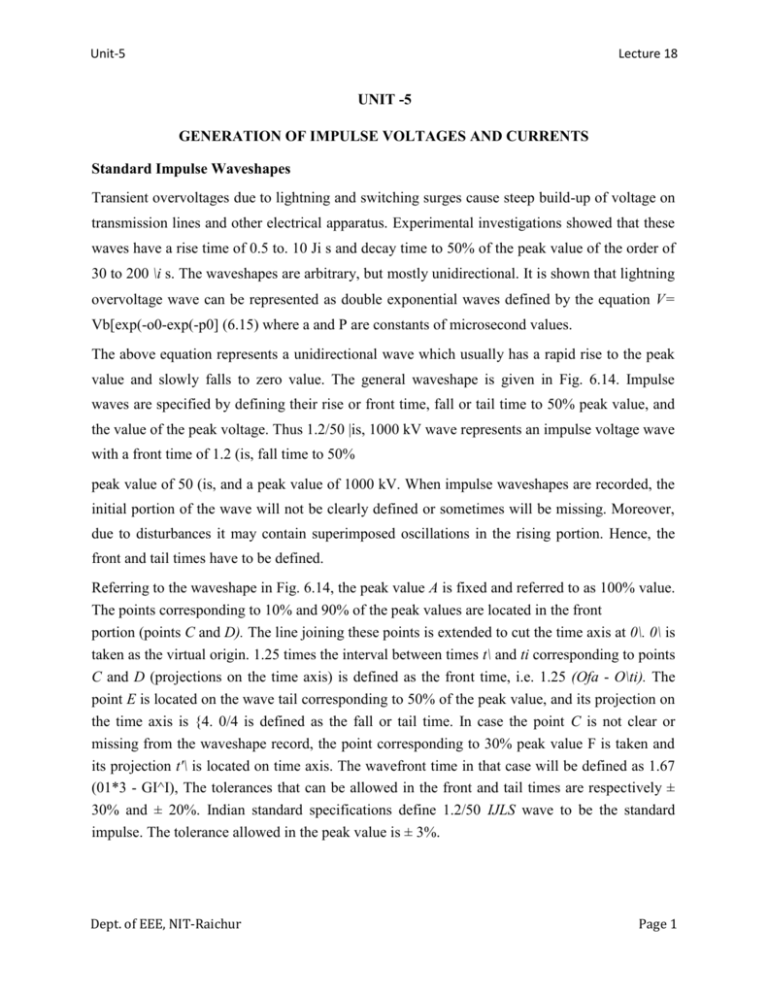wave corresponding
advertisement

Unit-5
Lecture 18
UNIT -5
GENERATION OF IMPULSE VOLTAGES AND CURRENTS
Standard Impulse Waveshapes
Transient overvoltages due to lightning and switching surges cause steep build-up of voltage on
transmission lines and other electrical apparatus. Experimental investigations showed that these
waves have a rise time of 0.5 to. 10 Ji s and decay time to 50% of the peak value of the order of
30 to 200 \i s. The waveshapes are arbitrary, but mostly unidirectional. It is shown that lightning
overvoltage wave can be represented as double exponential waves defined by the equation V=
Vb[exp(-o0-exp(-p0] (6.15) where a and P are constants of microsecond values.
The above equation represents a unidirectional wave which usually has a rapid rise to the peak
value and slowly falls to zero value. The general waveshape is given in Fig. 6.14. Impulse
waves are specified by defining their rise or front time, fall or tail time to 50% peak value, and
the value of the peak voltage. Thus 1.2/50 |is, 1000 kV wave represents an impulse voltage wave
with a front time of 1.2 (is, fall time to 50%
peak value of 50 (is, and a peak value of 1000 kV. When impulse waveshapes are recorded, the
initial portion of the wave will not be clearly defined or sometimes will be missing. Moreover,
due to disturbances it may contain superimposed oscillations in the rising portion. Hence, the
front and tail times have to be defined.
Referring to the waveshape in Fig. 6.14, the peak value A is fixed and referred to as 100% value.
The points corresponding to 10% and 90% of the peak values are located in the front
portion (points C and D). The line joining these points is extended to cut the time axis at 0\. 0\ is
taken as the virtual origin. 1.25 times the interval between times t\ and ti corresponding to points
C and D (projections on the time axis) is defined as the front time, i.e. 1.25 (Ofa - O\ti). The
point E is located on the wave tail corresponding to 50% of the peak value, and its projection on
the time axis is {4. 0/4 is defined as the fall or tail time. In case the point C is not clear or
missing from the waveshape record, the point corresponding to 30% peak value F is taken and
its projection t'\ is located on time axis. The wavefront time in that case will be defined as 1.67
(01*3 - GI^I), The tolerances that can be allowed in the front and tail times are respectively ±
30% and ± 20%. Indian standard specifications define 1.2/50 IJLS wave to be the standard
impulse. The tolerance allowed in the peak value is ± 3%.
Dept. of EEE, NIT-Raichur
Page 1
Unit-5
Lecture 18
Theoretical Representation of impulse Waves
The impulse waves are generally represented by the Eq. (6.15) given earlier. V0 in the equation
represents a factor that depends on the peak value. For impulse wave of 1.2/50 |is, a = - 0.0146,
JJ = - 2.467, and Vp = 1.04 when time t is expressed in microseconds, a and P control the front
and tail times of the wave respectively.
Dept. of EEE, NIT-Raichur
Page 2






